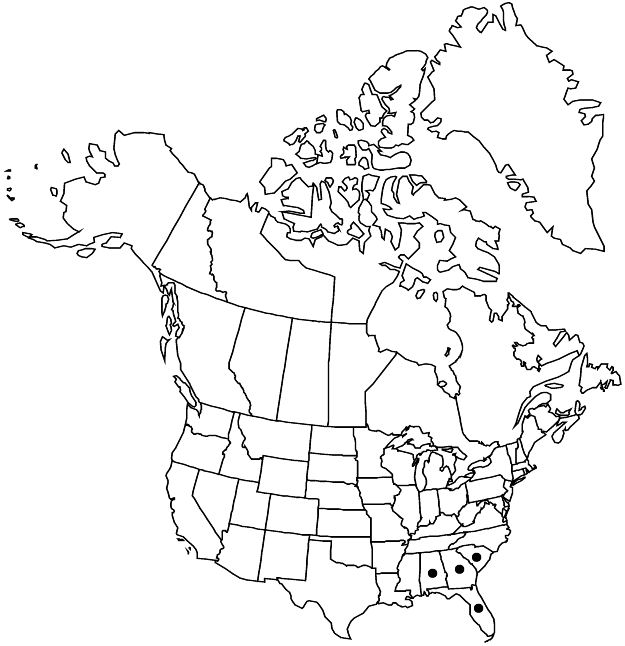Difference between revisions of "Piriqueta cistoides"
Fl. Brit. W. I., 298. 1860.
FNA>Volume Importer |
FNA>Volume Importer |
||
| Line 9: | Line 9: | ||
|special_status={{Treatment/ID/Special_status | |special_status={{Treatment/ID/Special_status | ||
|code=F | |code=F | ||
| − | |label= | + | |label=Illustrated |
}} | }} | ||
|basionyms={{Treatment/ID/Basionym | |basionyms={{Treatment/ID/Basionym | ||
|name=Turnera cistoides | |name=Turnera cistoides | ||
|authority=Linnaeus | |authority=Linnaeus | ||
| + | |rank=species | ||
|publication_title=Sp. Pl. ed. | |publication_title=Sp. Pl. ed. | ||
|publication_place=2, 1: 387. 1762 | |publication_place=2, 1: 387. 1762 | ||
| Line 30: | Line 31: | ||
|distribution=se United States;West Indies;South America. | |distribution=se United States;West Indies;South America. | ||
|discussion=<p>Subspecies 2 (1 in the flora).</p><!-- | |discussion=<p>Subspecies 2 (1 in the flora).</p><!-- | ||
| − | --><p>Within <i>Piriqueta</i>, <i>P. cistoides</i> has the widest distribution. Both subspecies show wide morphological variation; subsp. cistoides is homostylous and self compatible; < | + | --><p>Within <i>Piriqueta</i>, <i>P. cistoides</i> has the widest distribution. Both subspecies show wide morphological variation; subsp. cistoides is homostylous and self compatible; <i></i>subsp.<i> caroliniana</i> is distylous and self incompatible. In Cuba, Dominican Republic, and northern South America, intermediate specimens (10% of the total) cannot be assigned morphologically to one subspecies or the other. R. Ornduff (1970c) made crosses between and among the subspecies; he found no reproductive barriers among the different morphs of <i></i>subsp.<i> caroliniana</i>; the fertility of the hybrids between both subspecies was higher than that of the hybrids among populations of subsp. cistoides. Subspecies cistoides has been reported from Georgia; the author has not seen specimens.</p> |
|tables= | |tables= | ||
|references= | |references= | ||
| Line 39: | Line 40: | ||
-->{{#Taxon: | -->{{#Taxon: | ||
name=Piriqueta cistoides | name=Piriqueta cistoides | ||
| − | |||
|authority=(Linnaeus) Grisebach | |authority=(Linnaeus) Grisebach | ||
|rank=species | |rank=species | ||
| Line 50: | Line 50: | ||
|publication title=Fl. Brit. W. I., | |publication title=Fl. Brit. W. I., | ||
|publication year=1860 | |publication year=1860 | ||
| − | |special status= | + | |special status=Illustrated |
| − | |source xml=https://jpend@bitbucket.org/aafc-mbb/fna-data-curation.git/src/ | + | |source xml=https://jpend@bitbucket.org/aafc-mbb/fna-data-curation.git/src/f50eec43f223ca0e34566be0b046453a0960e173/coarse_grained_fna_xml/V6/V6_302.xml |
|genus=Piriqueta | |genus=Piriqueta | ||
|species=Piriqueta cistoides | |species=Piriqueta cistoides | ||
Revision as of 22:03, 16 December 2019
Distribution

se United States, West Indies, South America.
Discussion
Subspecies 2 (1 in the flora).
Within Piriqueta, P. cistoides has the widest distribution. Both subspecies show wide morphological variation; subsp. cistoides is homostylous and self compatible; subsp. caroliniana is distylous and self incompatible. In Cuba, Dominican Republic, and northern South America, intermediate specimens (10% of the total) cannot be assigned morphologically to one subspecies or the other. R. Ornduff (1970c) made crosses between and among the subspecies; he found no reproductive barriers among the different morphs of subsp. caroliniana; the fertility of the hybrids between both subspecies was higher than that of the hybrids among populations of subsp. cistoides. Subspecies cistoides has been reported from Georgia; the author has not seen specimens.
Selected References
None.